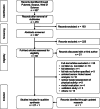Sensor-based fall risk assessment in older adults with or without cognitive impairment: a systematic review
- PMID: 34243722
- PMCID: PMC8272315
- DOI: 10.1186/s11556-021-00266-w
Sensor-based fall risk assessment in older adults with or without cognitive impairment: a systematic review
Abstract
Background: Higher age and cognitive impairment are associated with a higher risk of falling. Wearable sensor technology may be useful in objectively assessing motor fall risk factors to improve physical exercise interventions for fall prevention. This systematic review aims at providing an updated overview of the current research on wearable sensors for fall risk assessment in older adults with or without cognitive impairment. Therefore, we addressed two specific research questions: 1) Can wearable sensors provide accurate data on motor performance that may be used to assess risk of falling, e.g., by distinguishing between faller and non-faller in a sample of older adults with or without cognitive impairment?; and 2) Which practical recommendations can be given for the application of sensor-based fall risk assessment in individuals with CI? A systematic literature search (July 2019, update July 2020) was conducted using PubMed, Scopus and Web of Science databases. Community-based studies or studies conducted in a geriatric setting that examine fall risk factors in older adults (aged ≥60 years) with or without cognitive impairment were included. Predefined inclusion criteria yielded 16 cross-sectional, 10 prospective and 2 studies with a mixed design.
Results: Overall, sensor-based data was mainly collected during walking tests in a lab setting. The main sensor location was the lower back to provide wearing comfort and avoid disturbance of participants. The most accurate fall risk classification model included data from sit-to-walk and walk-to-sit transitions collected over three days of daily life (mean accuracy = 88.0%). Nine out of 28 included studies revealed information about sensor use in older adults with possible cognitive impairment, but classification models performed slightly worse than those for older adults without cognitive impairment (mean accuracy = 79.0%).
Conclusion: Fall risk assessment using wearable sensors is feasible in older adults regardless of their cognitive status. Accuracy may vary depending on sensor location, sensor attachment and type of assessment chosen for the recording of sensor data. More research on the use of sensors for objective fall risk assessment in older adults is needed, particularly in older adults with cognitive impairment.
Trial registration: This systematic review is registered in PROSPERO ( CRD42020171118 ).
Keywords: Cognition; Dementia; Elderly; Risk of falling; Wearable sensors.
© 2021. The Author(s).
Conflict of interest statement
The authors declare that they have no competing interests.
References
-
- Cox C, Vassallo M. Fear of falling assessments in older people with dementia. Rev Clin Gerontol. 2015;25(02):98–106. doi: 10.1017/S0959259815000106. - DOI
Publication types
LinkOut - more resources
Full Text Sources
Miscellaneous


